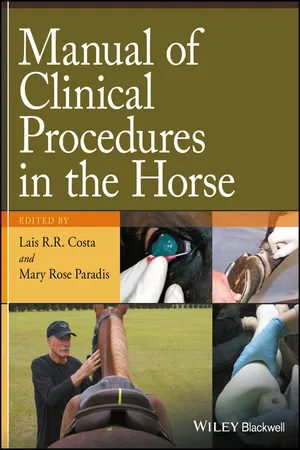
Manual of Clinical Procedures in the Horse
- English
- ePUB (mobile friendly)
- Available on iOS & Android
Manual of Clinical Procedures in the Horse
About this book
Manual of Clinical Procedures in the Horse is a detailed step-by-step guide to clinical skills in equine practice. With information on techniques ranging from physical examination and blood sampling to lameness and neurologic exams and other specialized procedures, the book is an aid to confidently and effectively performing procedures used in daily equine practice. Well illustrated with clinical photographs throughout, the book's focus is on providing thorough, easy-to-understand descriptions of 80 techniques necessary for examining and treating horses.
Each topic includes a summary of the purpose, potential complications, equipment and proper restraint for each procedure, with a detailed description of each action for the technique and the rationale behind it. More than 1, 100 full-colour clinical photographs demonstrate the techniques. Manual of Clinical Procedures in the Horse is an essential purchase for any veterinary practice seeing equine patients.
Key features
- Details each step for 80 common procedures for veterinary care of the horse
- Supports veterinarians and technicians in performing techniques in daily equine practice
- Presents more than 1, 100 images depicting the steps described in the text
- Covers the purpose, potential complications, equipment, restraint, actions and rationale for each procedure
- Offers a practical patient-side reference to essential techniques in clinical practice, ranging from basic assessment to specialized procedures
Frequently asked questions
- Essential is ideal for learners and professionals who enjoy exploring a wide range of subjects. Access the Essential Library with 800,000+ trusted titles and best-sellers across business, personal growth, and the humanities. Includes unlimited reading time and Standard Read Aloud voice.
- Complete: Perfect for advanced learners and researchers needing full, unrestricted access. Unlock 1.4M+ books across hundreds of subjects, including academic and specialized titles. The Complete Plan also includes advanced features like Premium Read Aloud and Research Assistant.
Please note we cannot support devices running on iOS 13 and Android 7 or earlier. Learn more about using the app.
Information
Part I
General Clinical Examinations and Routine Procedures
1
Principles of Horse Handling for Veterinarians: Horse Handling Versus Horse Restraint
Table of contents
- Cover
- Title Page
- Copyright
- List of Contributors
- Preface
- Acknowledgements
- Part I General Clinical Examinations and Routine Procedures
- Part II Clinical Procedures by Body Systems: Digestive System
- Part III Clinical Procedures by Body Systems: Respiratory System
- Part IV Clinical Procedures by Body Systems: Locomotor System
- Part V Clinical Procedures by Body Systems: Reproductive System
- Part VI Clinical Procedures in Neonatal Medicine A Clinical Assessment and Resuscitation of the Neonatal Foal
- B Instrumentation in the Neonatal Foal
- Part VII Clinical Procedures by Body Systems: Urinary System
- Part VIII Clinical Procedures by Body Systems: Ocular Procedures
- Part IX Clinical Procedures by Body Systems: Dermatological Procedures
- Part X Clinical Procedures by Body Systems: Neurologic Procedures
- Part XI Clinical Procedures by Body Systems: Miscellaneous Procedures
- Index
- EULA